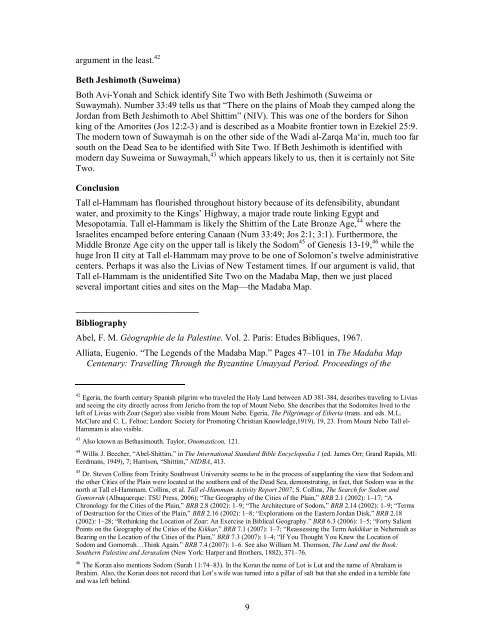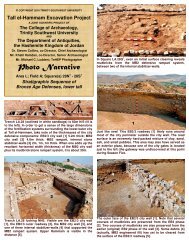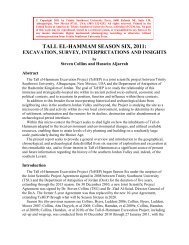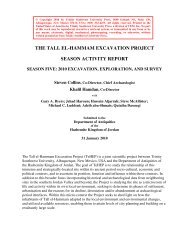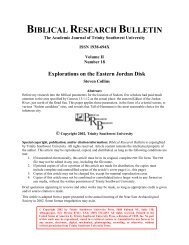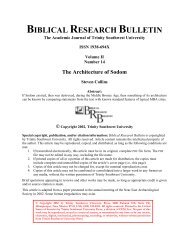Locating Tall el-Hammam on the Madaba Map
Locating Tall el-Hammam on the Madaba Map
Locating Tall el-Hammam on the Madaba Map
Create successful ePaper yourself
Turn your PDF publications into a flip-book with our unique Google optimized e-Paper software.
argument in <strong>the</strong> least. 42Beth Jeshimoth (Suweima)Both Avi-Y<strong>on</strong>ah and Schick identify Site Two with Beth Jeshimoth (Suweima orSuwaymah). Number 33:49 t<str<strong>on</strong>g>el</str<strong>on</strong>g>ls us that “There <strong>on</strong> <strong>the</strong> plains of Moab <strong>the</strong>y camped al<strong>on</strong>g <strong>the</strong>Jordan from Beth Jeshimoth to Ab<str<strong>on</strong>g>el</str<strong>on</strong>g> Shittim” (NIV). This was <strong>on</strong>e of <strong>the</strong> borders for Sih<strong>on</strong>king of <strong>the</strong> Amorites (Jos 12:2-3) and is described as a Moabite fr<strong>on</strong>tier town in Ezeki<str<strong>on</strong>g>el</str<strong>on</strong>g> 25:9.The modern town of Suwaymah is <strong>on</strong> <strong>the</strong> o<strong>the</strong>r side of <strong>the</strong> Wadi al-Zarqa Ma‘in, much too farsouth <strong>on</strong> <strong>the</strong> Dead Sea to be identified with Site Two. If Beth Jeshimoth is identified withmodern day Suweima or Suwaymah, 43 which appears lik<str<strong>on</strong>g>el</str<strong>on</strong>g>y to us, <strong>the</strong>n it is certainly not SiteTwo.C<strong>on</strong>clusi<strong>on</strong><str<strong>on</strong>g>Tall</str<strong>on</strong>g> <str<strong>on</strong>g>el</str<strong>on</strong>g>-<str<strong>on</strong>g>Hammam</str<strong>on</strong>g> has flourished throughout history because of its defensibility, abundantwater, and proximity to <strong>the</strong> Kings’ Highway, a major trade route linking Egypt andMesopotamia. <str<strong>on</strong>g>Tall</str<strong>on</strong>g> <str<strong>on</strong>g>el</str<strong>on</strong>g>-<str<strong>on</strong>g>Hammam</str<strong>on</strong>g> is lik<str<strong>on</strong>g>el</str<strong>on</strong>g>y <strong>the</strong> Shittim of <strong>the</strong> Late Br<strong>on</strong>ze Age, 44 where <strong>the</strong>Isra<str<strong>on</strong>g>el</str<strong>on</strong>g>ites encamped before entering Canaan (Num 33:49; Jos 2:1; 3:1). Fur<strong>the</strong>rmore, <strong>the</strong>Middle Br<strong>on</strong>ze Age city <strong>on</strong> <strong>the</strong> upper tall is lik<str<strong>on</strong>g>el</str<strong>on</strong>g>y <strong>the</strong> Sodom 45 of Genesis 13-19, 46 while <strong>the</strong>huge Ir<strong>on</strong> II city at <str<strong>on</strong>g>Tall</str<strong>on</strong>g> <str<strong>on</strong>g>el</str<strong>on</strong>g>-<str<strong>on</strong>g>Hammam</str<strong>on</strong>g> may prove to be <strong>on</strong>e of Solom<strong>on</strong>’s tw<str<strong>on</strong>g>el</str<strong>on</strong>g>ve administrativecenters. Perhaps it was also <strong>the</strong> Livias of New Testament times. If our argument is valid, that<str<strong>on</strong>g>Tall</str<strong>on</strong>g> <str<strong>on</strong>g>el</str<strong>on</strong>g>-<str<strong>on</strong>g>Hammam</str<strong>on</strong>g> is <strong>the</strong> unidentified Site Two <strong>on</strong> <strong>the</strong> <strong>Madaba</strong> <strong>Map</strong>, <strong>the</strong>n we just placedseveral important cities and sites <strong>on</strong> <strong>the</strong> <strong>Map</strong>—<strong>the</strong> <strong>Madaba</strong> <strong>Map</strong>.___________________________BibliographyAb<str<strong>on</strong>g>el</str<strong>on</strong>g>, F. M. Géographie de la Palestine. Vol. 2. Paris: Etudes Bibliques, 1967.Alliata, Eugenio. “The Legends of <strong>the</strong> <strong>Madaba</strong> <strong>Map</strong>.” Pages 47–101 in The <strong>Madaba</strong> <strong>Map</strong>Centenary: Trav<str<strong>on</strong>g>el</str<strong>on</strong>g>ling Through <strong>the</strong> Byzantine Umayyad Period. Proceedings of <strong>the</strong>42 Egeria, <strong>the</strong> fourth century Spanish pilgrim who trav<str<strong>on</strong>g>el</str<strong>on</strong>g>ed <strong>the</strong> Holy Land between AD 381-384, describes trav<str<strong>on</strong>g>el</str<strong>on</strong>g>ing to Liviasand seeing <strong>the</strong> city directly across from Jericho from <strong>the</strong> top of Mount Nebo. She describes that <strong>the</strong> Sodomites lived to th<str<strong>on</strong>g>el</str<strong>on</strong>g>eft of Livias with Zoar (Segor) also visible from Mount Nebo. Egeria, The Pilgrimage of E<strong>the</strong>ria (trans. and eds. M.L.McClure and C. L. F<str<strong>on</strong>g>el</str<strong>on</strong>g>toe; L<strong>on</strong>d<strong>on</strong>: Society for Promoting Christian Knowledge,1919), 19, 23. From Mount Nebo <str<strong>on</strong>g>Tall</str<strong>on</strong>g> <str<strong>on</strong>g>el</str<strong>on</strong>g>-<str<strong>on</strong>g>Hammam</str<strong>on</strong>g> is also visible.43 Also known as Bethasimouth. Taylor, Onomastic<strong>on</strong>, 121.44 Willis J. Beecher, “Ab<str<strong>on</strong>g>el</str<strong>on</strong>g>-Shittim,” in The Internati<strong>on</strong>al Standard Bible Encyclopedia 1 (ed. James Orr; Grand Rapids, MI:Eerdmans, 1949), 7; Harris<strong>on</strong>, “Shittim,” NIDBA, 413.45 Dr. Steven Collins from Trinity Southwest University seems to be in <strong>the</strong> process of supplanting <strong>the</strong> view that Sodom and<strong>the</strong> o<strong>the</strong>r Cities of <strong>the</strong> Plain were located at <strong>the</strong> sou<strong>the</strong>rn end of <strong>the</strong> Dead Sea, dem<strong>on</strong>strating, in fact, that Sodom was in <strong>the</strong>north at <str<strong>on</strong>g>Tall</str<strong>on</strong>g> <str<strong>on</strong>g>el</str<strong>on</strong>g>-<str<strong>on</strong>g>Hammam</str<strong>on</strong>g>. Collins, et al. <str<strong>on</strong>g>Tall</str<strong>on</strong>g> <str<strong>on</strong>g>el</str<strong>on</strong>g>-<str<strong>on</strong>g>Hammam</str<strong>on</strong>g> Activity Report 2007; S. Collins, The Search for Sodom andGomorrah (Albuquerque: TSU Press, 2006); “The Geography of <strong>the</strong> Cities of <strong>the</strong> Plain,” BRB 2.1 (2002): 1–17; “AChr<strong>on</strong>ology for <strong>the</strong> Cities of <strong>the</strong> Plain,” BRB 2.8 (2002): 1–9; “The Architecture of Sodom,” BRB 2.14 (2002): 1–9; “Termsof Destructi<strong>on</strong> for <strong>the</strong> Cities of <strong>the</strong> Plain,” BRB 2.16 (2002): 1–8; “Explorati<strong>on</strong>s <strong>on</strong> <strong>the</strong> Eastern Jordan Disk,” BRB 2.18(2002): 1–28; “Rethinking <strong>the</strong> Locati<strong>on</strong> of Zoar: An Exercise in Biblical Geography.” BRB 6.3 (2006): 1–5; “Forty SalientPoints <strong>on</strong> <strong>the</strong> Geography of <strong>the</strong> Cities of <strong>the</strong> Kikkar,” BRB 7.1 (2007): 1–7; “Reassessing <strong>the</strong> Term hakikkar in Nehemiah asBearing <strong>on</strong> <strong>the</strong> Locati<strong>on</strong> of <strong>the</strong> Cities of <strong>the</strong> Plain,” BRB 7.3 (2007): 1–4; “If You Thought You Knew <strong>the</strong> Locati<strong>on</strong> ofSodom and Gomorrah…Think Again.” BRB 7.4 (2007): 1–6. See also William M. Thoms<strong>on</strong>, The Land and <strong>the</strong> Book:Sou<strong>the</strong>rn Palestine and Jerusalem (New York: Harper and Bro<strong>the</strong>rs, 1882), 371–76.46 The Koran also menti<strong>on</strong>s Sodom (Surah 11:74–83). In <strong>the</strong> Koran <strong>the</strong> name of Lot is Lut and <strong>the</strong> name of Abraham isIbrahim. Also, <strong>the</strong> Koran does not record that Lot’s wife was turned into a pillar of salt but that she ended in a terrible fateand was left behind.9


